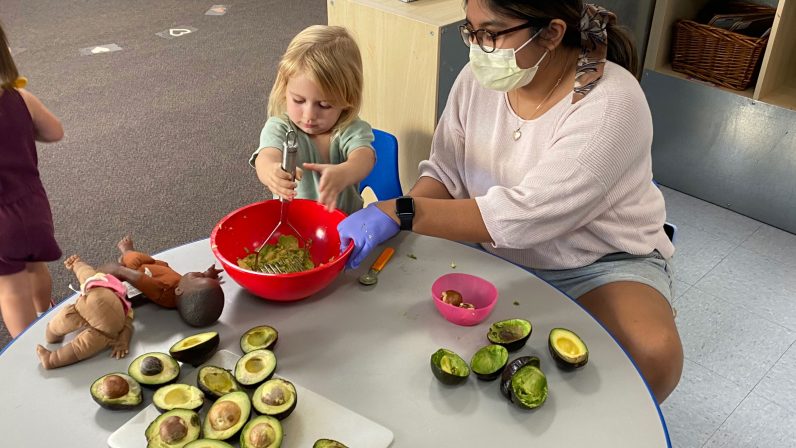I write this week’s blog from rural Nebraska, where I’m staying for a few days, helping out with my parents. I collected classroom stories about our nutrition study before I left, and lots of wonderful food experiences have happened since I left. My intention in writing about the study is to give you a bit of history regarding how it started, and to use it as an example of what the emergent curriculum model looks like at the different grade levels.
As with many parts of the Seed, one small moment became a movement. A conversation about how to improve children’s engagement with their lunches became a research project, a compilation of lunch resources, an annual school-wide nutrition study, and eventually a website. The original discussion evolved from reading this article about developmentally appropriate food practices with young children. Over time we’ve learned new things about nutrition and children, and have attempted to update our resources and information. We wanted to offer as much support as possible to parents, who have the task of making their children’s lunches every day. Parental response to our healthy lunch campaign has been, and continues to be, overwhelmingly positive. Most of the lunches we see are appealing and nutritionally robust. Our children benefit from this commitment to strong nutrition by the adults in their lives.
At school we support this effort by helping children build a strong foundational relationship with food. Each year we dedicate two weeks in early September to exploring food through books, direct sensory experiences, and investigations. The work looks different, of course, based on the age of the students. Teachers set the stage, offer invitations, and respond to the children’s interests. Out of this, the curriculum is formed. Here’s what it looks like in each of the general age groups:
In the toddler classes, their studies start with food songs, test tastes, and sampling of new foods. Books like Eric Carle’s The Very Hungry Caterpillar serve as a starting point for new vocabulary words. Words like “mandarine” and “watermelon” roll off the tongues of toddlers as they become acquainted with these new foods through taste, smell, touch, and sight. Their food experiences eventually lead into their upcoming gardening study through learning about composting.
Preschoolers take it up a notch by talking about growing foods and foods that aren’t so healthy for their bodies. They begin to identify the colors of foods and talk about foods that come from different places. The Early 3s class has been studying what plants need to grow, and learned about the life cycle of how plants grow through time lapse videos of sunflowers and carrots.
Older preschool classes have been cooking and tasting the different food groups, such as pinto beans for protein and tortillas for grains. Preschool 4s students are making individual jars of pesto to take home, using basil from their garden. PreK children have utilized their dramatic play area and turned it into the PreK Cafe. Students take turns being the customer and server to familiarize themselves with various fruits and veggies. They’ve learned about parts of a vegetable (stem, leaf, and root) and are currently making a dictionary of fruits and vegetables.
Kindergarteners have been sketching vegetables and exploring books about food, such as Cloudy with a Chance of Meatballs. They’ve learned about food groups through the MyPlate website. Favorite fruits were listed for a fruit salad, which included dissecting fruit as part of the process. The first and second graders have embarked on their study by starting with a book called Good Enough to Eat by Lizzy Rockwell. They’re learning about the importance of protein and fiber in their diets. Their study is still evolving as they consider moving into topics about the uniqueness of each body, and body image. The third and fourth graders chose sugar as their focal point after generating lots of topics and questions related to what they correlated to nutrition as a whole. They came up with an interesting list of questions to explore. Here are a few of their questions:
What is sugar?
What happens when you eat a lot of sugar?
Where does sugar come from?
Why when you eat sugar, most of the time, do you want more of it?
Why do parents not want kids to eat too much sugar?
What is a sugar rush?
Why does sugar taste so good but your body doesn’t like it?
Can vitamins and sugar be in the same food?
As with the first and second graders, this study is still evolving. In years past, some of the studies have extended well beyond the initial two weeks. This is a pattern that we hope will continue into our students’ lives, that they’ll have a curiosity about and interest in what goes into their bodies. It’s our intention that the Seed nutrition study will contribute to a long and healthy relationship with food for each of our students.

